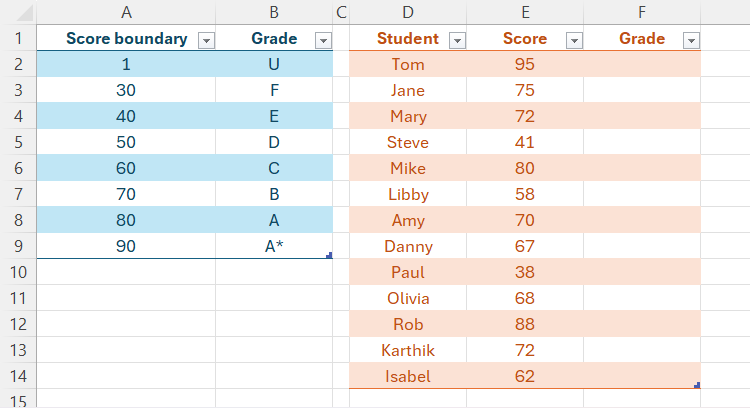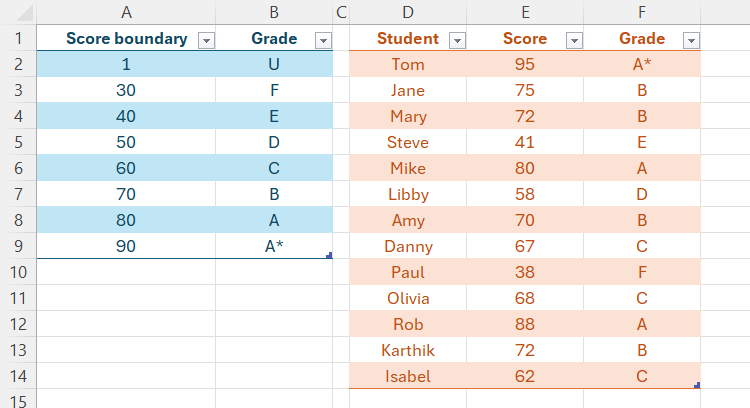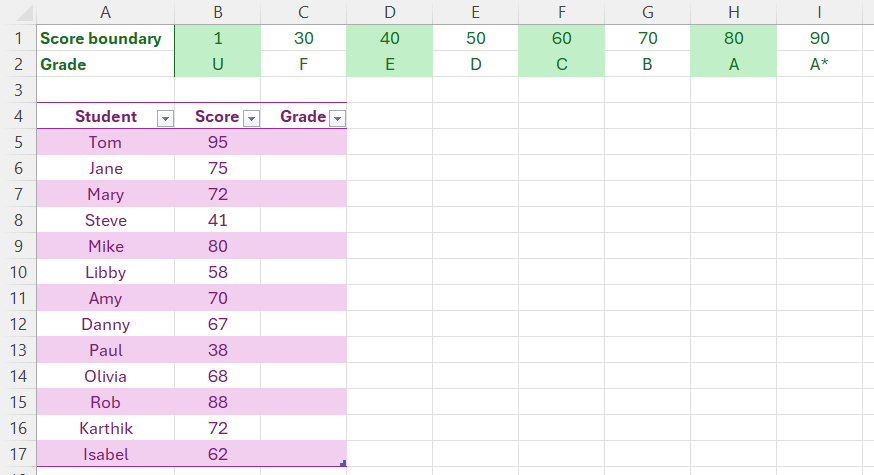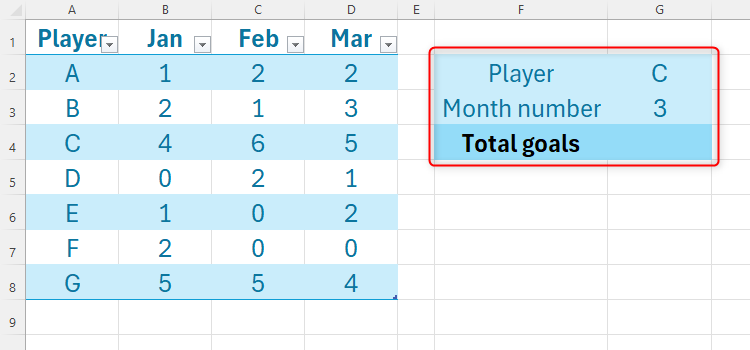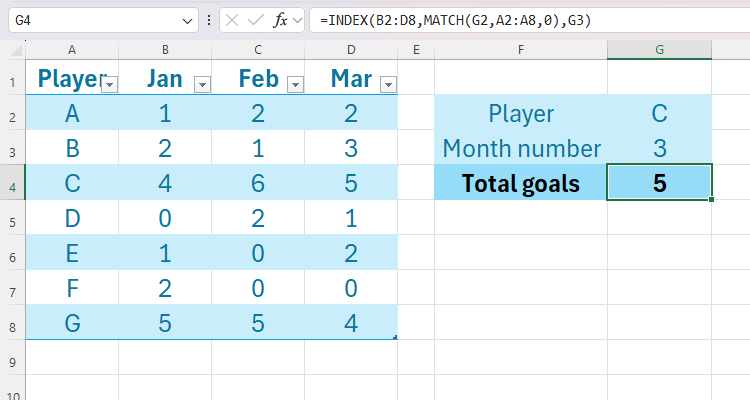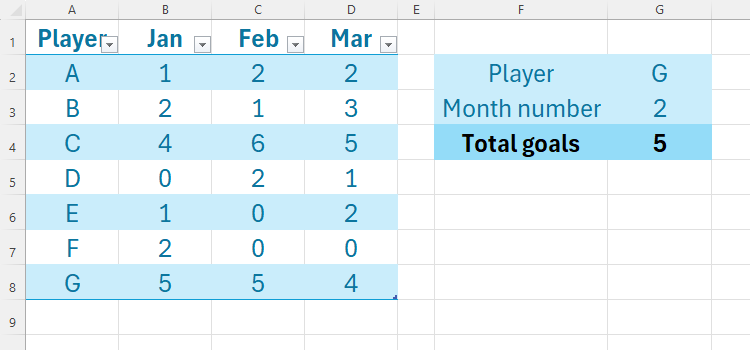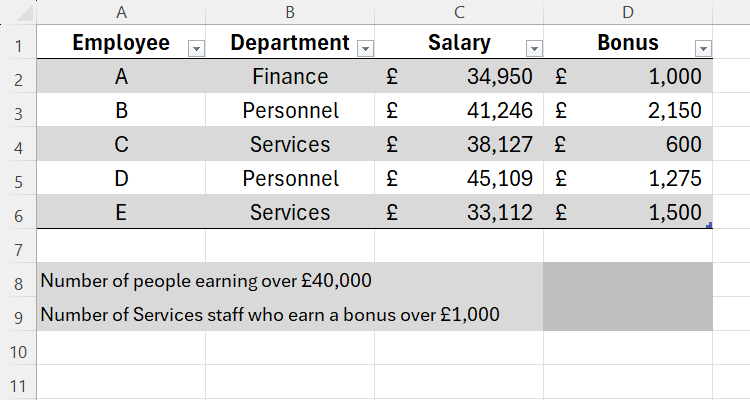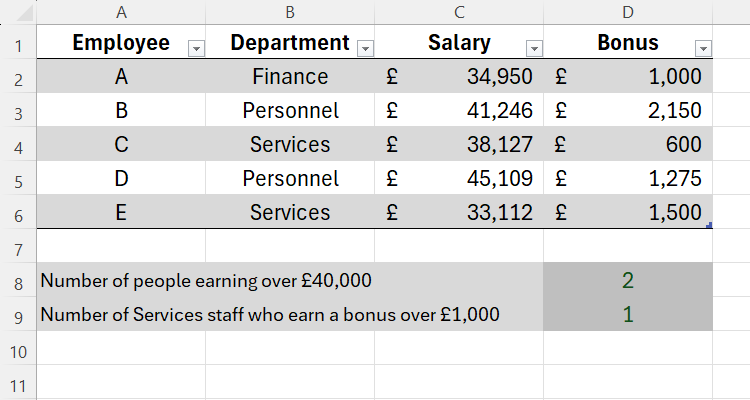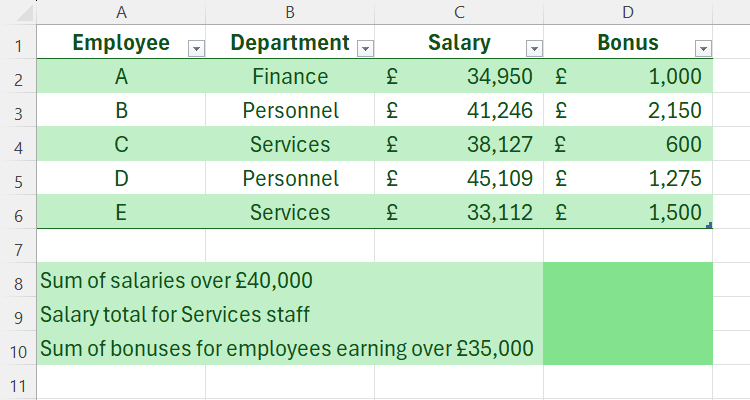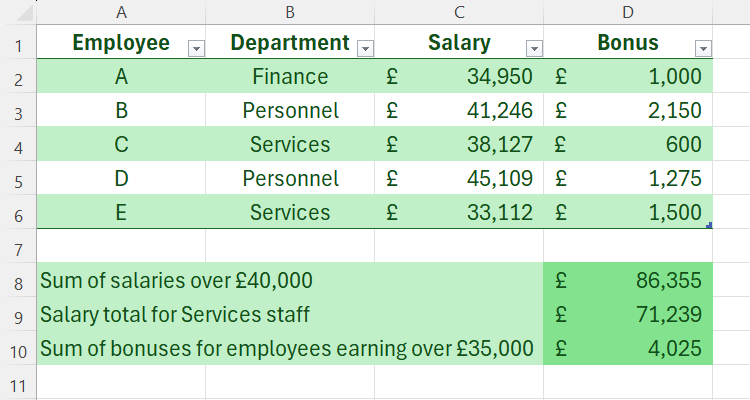Picture this—you have a large workbook full of nicely formatted, filtered, and sorted tables. You might think that your work is done, but actually, Excel is sitting and waiting for you to do more with those tables, eager to help you make the most of the hard work you have done so far.
In this article, I’ll run through three of the functions or combinations of functions I use the most when I want to either extract or summarize information in my Excel tables.
VLOOKUP and HLOOKUP
VLOOKUP and HLOOKUP are both used to locate and retrieve a value from specific locations in a table.
- VLOOKUP relies on the data table being vertical, and looks up the first column (vertical) in a table.
- HLOOKUP relies on the data table being horizontal, and looks up the first row (horizontal) in a table.
VLOOKUP
Here, I have a list of exam grades and the scores required for each grade (let’s call this table 1). I also have a table containing students’ scores (table 2 from this point). I want Excel to use the information in table 1 to complete the missing column in table 2.
I will use VLOOKUP, because I want Excel to look up the values in the first column of table 1 to return each student’s grade in table 2. The VLOOKUP function has the following syntax:
=VLOOKUP(a,b,c,d)
where
- a is the value to look up (in the example above, that’s the values in column E),
- b is the table containing the reference values (in this case, it’s cells A1 to B9, or table 1),
- c is the column number in that table (I want it to return the grade, so it’s the second column in table 1), and
- d is an optional criterion that tells Excel to look up the values approximately (“TRUE”) or exactly (“FALSE”). If left blank, the default value is TRUE.
So, in my case, I’ll type this formula into cell F2 to work out Tom’s grade, before using AutoFill to look up the other grades in the table:
=VLOOKUP(E2,$A$1:$B$9,2,TRUE)
I’ve used $ symbols to create an
absolute reference
for value
b
above, as I want Excel to continually use cells A1 to B9 to look up the values. I’ve also used “TRUE” for value
d
, as the score boundary table contains ranges, and not a grade assigned to individual scores.
HLOOKUP
Here, we have the same grade boundary information, but this time, it’s displayed horizontally. This means the data we want to fetch is in the second row of the boundary table.
The HLOOKUP function has a similar syntax to VLOOKUP:
=HLOOKUP(a,b,c,d)
where
- a is the value to look up (in this example, the values in column C),
- b is an absolute reference to the cells containing the lookup value (in this case, it’s A1 to I2),
- c is the row number in that table (I want it to return the grade, so it’s the second row), and
- d (optional) is either “TRUE” for approximate values, or “FALSE” for exact values.
So, I’ll type this formula into cell C5 to work out Tom’s grade, before using AutoFill to look up the other grades in the table:
=HLOOKUP(B5,$A$1:$I$2,2,TRUE)
INDEX With MATCH
Another effective way to look up and retrieve values is through INDEX and MATCH, especially when used together. INDEX finds and returns a value in a defined location, while MATCH finds and returns the location of a value. Together, they enable dynamic data retrieval.
Individual Syntaxes
Before we look at using these functions together, let’s briefly look at them individually.
The syntax for INDEX is
INDEX(a,b,c)
where a is the range of cells containing the data, b is the row number to evaluate, and c is the column number to evaluate.
On this basis,
INDEX(B2:D8,4,2)
would evaluate cells B2 to D8, and return the value in the fourth row and second column within that range.
For MATCH, we follow
MATCH(x,y,z)
where x is the value we’re looking up, y is the range where the value is to be found, and z (optional) is the match type.
On this basis,
MATCH(5,B2:B8,0)
would tell me where the number 5 is located within the range B2 to B8, and the 0 tells Excel to perform an exact match.
Used Together
In this example, I want Excel to tell me the number of goals a specified player has scored in a given month. More specifically, I want to know how many goals player C has scored in the third month, but I’m going to create this formula so that I can change these criteria at any time.
To achieve this, I need Excel to determine where player C is in the table, and then tell me what value is in the third column of the data.
In cell G4, I’ll start with the INDEX function, as I want Excel to find and return a value from my raw data. Then, I’ll tell Excel where to look for that data.
=INDEX(B2:D8,
The next part of the INDEX syntax is the row number, and this will vary depending on which player I state in cell G2. For example, if I want to look up player A, it’ll be the first row. To do this, I’ll initiate the MATCH function, as I want Excel to match the player I’ve typed into cell G2 with the corresponding cell in the player column (A2:A8), and work out which row number it’s on. I’ve also added a 0 at the end, as I want Excel to return an exact retrieval.
=INDEX(B2:D8,MATCH(G2,A2:A8,0),
Now that I’ve told Excel the row number for the INDEX function, I need to finish with the column number. In my case, the column number represents the month number I’ve typed into cell G3.
=INDEX(B2:D8,MATCH(G2,A2:A8,0),G3)
When I press Enter, Excel correctly informs me that player C scored five goals in the third month.
Now, I can change any of the values in my lookup table to find any player’s total for any of the months.
COUNTIF and SUMIF
As you may gather from their names, these two functions count and sum values based on criteria you set. Anything not included within your criteria will not be added or counted, even if it’s within the range you specify.
COUNTIF
COUNTIF counts cells containing certain criteria. The syntax is
COUNTIF(a,b)
where a is the range you want to count, and b is the criteria for counting.
Similarly, if I wanted to include more than one criterion, I’d use COUNTIFS:
COUNTIFS(a,b,c,d)
where a and b are the first range-criteria pairing, and c and d are the second range-criteria pairing (you can have up to 127 pairings).
If any criteria are text or a logical or mathematical symbol, they must be enclosed in double-quotes.
In my salary table below, I want to calculate the number of people earning over £40,000 and, separately, the number of service staff who earn a bonus of over £1,000.
To count the number of workers with a salary of over £40,000, I need to type this formula into cell D8:
=COUNTIF(C2:C6,">40000")
where C2:C6 is the range where the salaries are located, and “>40000” is the criterion.
To calculate the number of service personnel who earn bonuses of over £1,000, I would use COUNTIFS, as I have two criteria.
=COUNTIFS(B2:B6,"Services",D2:D6,">1000")
The B2:B6,”Services” part is the first range-criterion pairing, and D2:D6,”>1000″ is the second.
Even though there are commas separating the thousands in my table above, I haven’t included these within the formula, as commas have a different function in this context.
SUMIF
SUMIF sums cells based on criteria you set. It works on a similar principle as COUNTIF, but with more arguments in the parentheses. The syntax is
SUMIF(a, b, c)
where a is the range of cells you want to evaluate before making the sum, b is the criteria for that evaluation (this can be a value or a cell reference), and c (optional) is the cells to add if different to a.
This time, we have three things to work out: the sum of the salaries over £40,000, the total salary for the service department, and the sum of the bonuses for staff whose salary is over £35,000.
First, to work out the sum of the salaries over £40,000, I need to type the following formula into cell D8:
=SUMIF(C2:C6,">40000")
where C2:C6 references the salaries in the table, and “>40000” tells Excel to only sum the values over this amount.
Next, I want to find out the total salary for the services department. So, in cell C9, I’ll type
=SUMIF(B2:B6,"Services",C2:C6)
where B2:B6 references the department column, “Services” tells Excel that I’m looking specifically for employees in the services department, and C2:C6 tells Excel to sum the salaries of these employees.
My last task is to find out how much employees earning over £35,000 have made in bonuses. In cell C10, I’ll input
=SUMIF(C2:C6,">35000",D2:D6)
where C2:C6 tells Excel to evaluate the salaries, “>35000” is the criterion for those salaries, and D2:D6 tells Excel to sum the bonuses of those individuals who fulfill the criterion.
Excel also has a SUMIFS function, which carries out the same process but for more than one criterion. It has a very different syntax to SUMIF:
SUMIFS(a,b,c,d,e)
where a is the range of cells to sum, b is the first range that is evaluated, c is the criterion for b, and d and e are the next range-criterion pairing (you can have up to 127 pairs).
Using the table above, let’s say I wanted to sum up the bonuses for personnel staff earning over £45,000. Here’s the formula I would type:
=SUMIFS(D2:D6,B2:B6,"Personnel",C2:C6,">45000")
Once you’ve mastered the functions detailed above, try the XLOOKUP function, which aims to address some of VLOOKUP’s shortcomings by looking up values to the left and right of the lookup value column without you having to rearrange your data.


